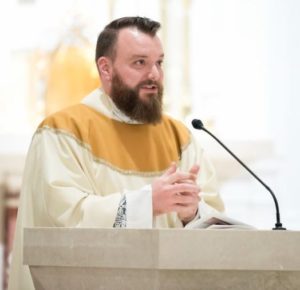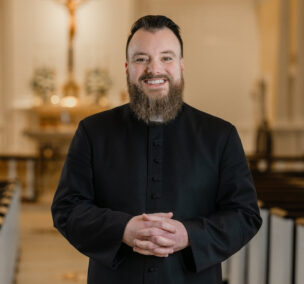 Dear Brothers and Sisters in Christ,
Dear Brothers and Sisters in Christ,
As Passiontide begins, our focus turns more intensely to those events we have been preparing to celebrate throughout this season. These final days of Lent are an invitation to further turn our minds and hearts to the Lord. Nearly five weeks ago we heard those words that have guided us throughout Lent: “Repent and believe in the Gospel.” To turn away from sin means to turn toward the Lord. This movement toward God involves the whole of our being, body and soul. Prayer, fasting, and almsgiving are the disciplines that help us to reorient our lives so that we may truly be ad orientem, facing east, to the light of Christ. These practices, by turning us to God, enable the light of the Gospel to enlighten our hearts.
Reorientation of life toward God is a task to which each individual Catholic is called. Yet it is not a solitary journey. Rather, five weeks ago we embarked together, setting out as a community of believers so that each individually and all collectively could turn to face God. Here a particular balance must be struck. On the one hand, as we read in the Gospel on Ash Wednesday, when we do some righteous act we should not let our left hand know what our right hand is doing. Our particular penances and spiritual practices in Lent are, in a certain way, private. On the other hand, one of the most common refrains among Catholics during Lent is the question “What did you give up for Lent?” This is a reflection of the communal nature of the Church’s discipline in this holy season. We are all in this together. Fasting, in particular, becomes the discipline that reminds us that we do not go on this journey alone. We know that our Catholic friends and family members are abstaining from meat with us on Fridays. Chances are high that we talk with someone who has given up the same thing as us, or even that we are part of a group fasting from the same things. Before a visit to a parishioner’s home recently, I was asked what I had given up for Lent so they could plan a meal accordingly. Truly when we fast, we do so not only as individuals, but also as a community. The Lenten fast reminds us that we turn to the Lord, body and soul, as a whole community of believers.
Our almsgiving is also a communal act. While my reflection last week focused primarily on individual giving, we should remember that there is always a communal dimension to this giving. Think, for example, of the ongoing collection of food we have here at St. Pius that benefits area soup kitchens and food pantries. Individuals give, but those single offerings make possible a gift in the name of our whole community. When we pitch in with hands and skills, we are able to accomplish many things for the good of our brothers and sisters. As I said last week, almsgiving is not something reserved to a small group of persons but rather is a common call to each believer. Lenten almsgiving demonstrates in a visible way our common reorientation to the Lord by means of our service and generosity to others.
Prayer is one of the ways we see our common turn toward God expressed most clearly. When I began these reflections, recall that I pointed to the architectural orientation of the church building. Built on an east-west axis, the sanctuary of the church represents the east, which in Christian art and symbolism points us to Jesus. The East is not to be understood exclusively as a geographical direction, but rather as a symbol for that place where the rising sun, Jesus Christ, begins to bring His light to the entire world. To be ad orientem (literally “to the east”) means (symbolically) to be turned to Jesus. Our communal prayer, expressed most frequently in the Eucharistic liturgy, is always, by its very nature, ad orientem. The congregation gathered by the Lord faces the same direction – toward the altar, the sanctuary, the Tabernacle where Jesus is truly present, the east – as we worship. Our voices are raised in unison as we praise God and place our needs before Him. We fall silent together at certain moments so that as one, our prayers can be offered to the Lord. In every Mass, we see our reorientation to the Lord expressed in word, in heart, and in physical posture. The Church teaches us that the liturgy should be a lived reflection of the internal disposition of the community gathered for worship. Prayer ad orientem is first an internal reality. Since we pray even with the body, our orientation is also physical. Hence, all in the church face the same direction, united as the one Body of Christ gathered for worship.
If I may cause a small controversy for a moment…as the community adopts a common posture and physical orientation – just as we have adopted common disciplines and practices which help us individually and also are a sign of our unity in faith – there is one person in the community who is conspicuously excluded from this common posture. The priest is the one not facing the same direction as the congregation for almost the entire Mass. In fact, he quite literally has his back turned on Jesus present in the Tabernacle! An unfortunate description has crept into Catholic usage in the last 50 or so years: the idea that before Vatican II, the priest “turned his back on the people” to celebrate Mass. Unfortunately for proponents of this vision, no theologian, none of the ancient Fathers of the Church, no saint, no liturgical author, no rubric of the Church’s books of prayer, ever used such language. It was invented out of whole cloth to misrepresent the posture the priest took. On the contrary, the priest stood at the head of the assembled community, standing with them before God. For the priest to face toward the altar instead of toward the congregation reminded the priest that he is not separate from the People of God, but rather one of them, charged with a particular responsibility to stand before God on behalf of the whole community. If the phrase “turned his back on the people” is still in our vocabulary, we would do well to permanently delete it as soon as possible. Many of you were likely taught that Vatican II mandated that the priest face the people for the Mass. Unfortunately for those who teach such a thing, the Second Vatican Council did not say a single word about what direction the priest would face during Mass. While post-Conciliar liturgical directives permit the priest to face the congregation, the Church has repeatedly affirmed that Mass may be celebrated ad orientem, facing the altar, facing the Lord.
In the years following the Council, many important liturgical symbols were thrown away. Included as a casualty was the common orientation of the priest standing with the people. During the quarantine, while live-streaming Masses in an empty chapel, I became acutely aware of the fact that I was not facing toward the Lord. Seeing only empty pews and a camera in front of me, I was intensely conscious of the presence of Jesus in the Eucharist in the Tabernacle behind me. The logic of facing toward Him rather than the invisible internet was extremely clear. The purpose of live-streaming Masses was, and remains, to help our whole community remain united in turning to the Lord. But with no congregation, the fact that my physical posture did not match my purpose in offering (and streaming) the Mass became very clear. Celebrating the Extraordinary Form of the Mass during the quarantine gave me a concrete experience of celebrating ad orientem, which in turn inspired in my heart a sense of prayerful union with the parish community. Spiritually, it was one of the most important things I have experienced in six years as pastor. Since we shut down a year ago, this has burned in my heart and mind. These last few weeks have helped me reflect more on what it means to be turned toward God, and I am grateful for your kindness in allowing me to share my thoughts. Before one final reflection on all this next week, I want to ask two things of you. First, please prayerfully reflect on the direction the priest faces, in light of all that I have written and said about our Lenten disciplines turning us more to the Lord, not only for forty days, but for our entire lives. Second, I ask you this question: would you be comfortable allowing me to stand with you in a common orientation of prayer, as one of you, as one who serves you, as one united interiorly and exteriorly in worship of almighty God?
Peace,

Fr. Sam


